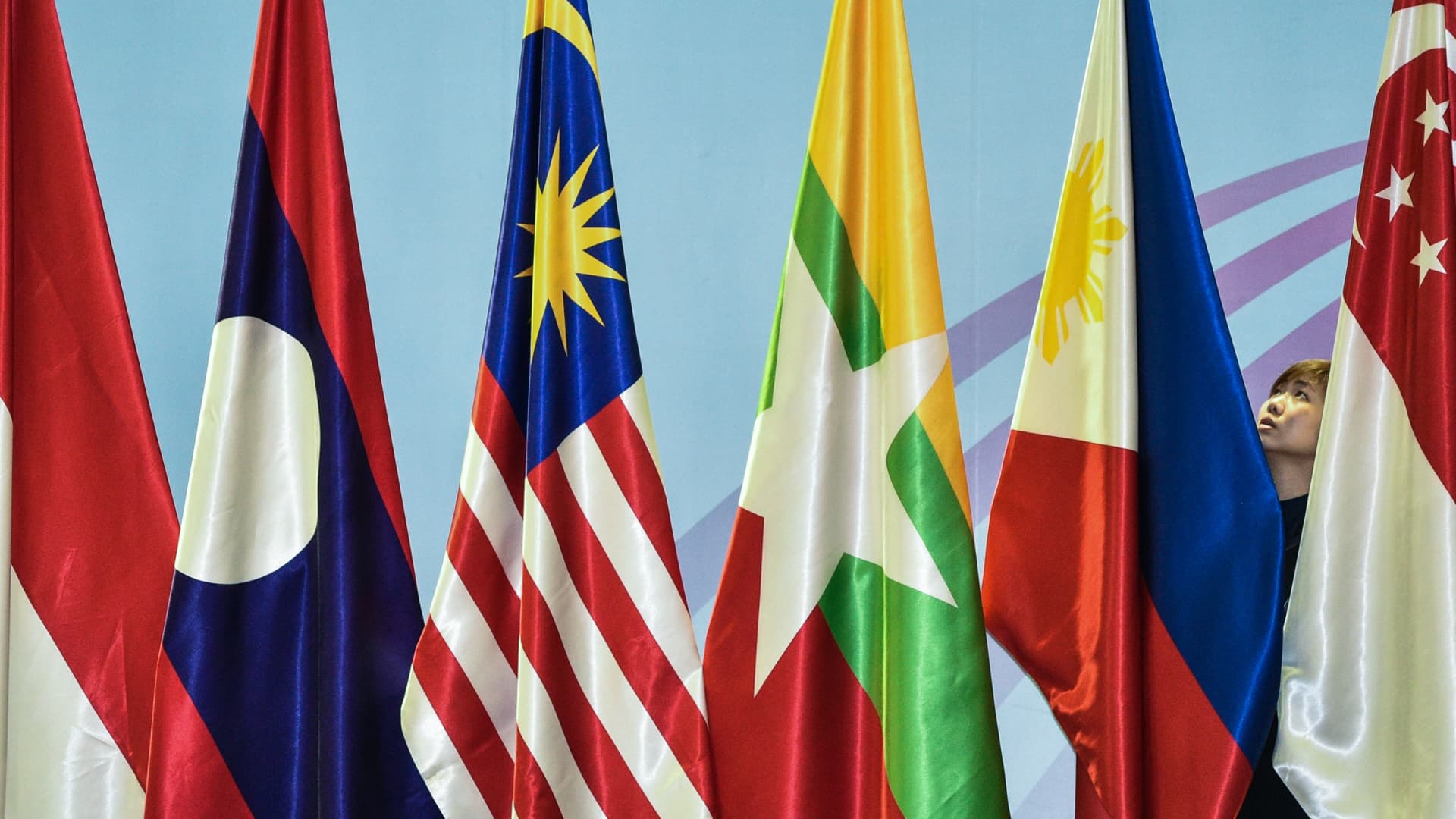
A woman (R) adjusts the Philippines flag before the 51st Association of Southeast Asian Nations (ASEAN)- Republic of Korea Ministerial Meeting in Singapore on August 3, 2018.
Mohd Rasfan | Afp | Getty Images
Southeast Asia’s digital economy has plenty of growth potential, backed by strong fundamentals including over 460 million digital consumers, young and tech-savvy populations, as well as rising internet penetration.
The digital economy across six countries within the Association of Southeast Asian Nations bloc — known as ASEAN-6 and comprising Indonesia, Malaysia, the Philippines, Singapore, Thailand, and Vietnam — is projected to grow 6% annually.
That’s according to the latest e-Conomy SEA 2022 report released by Google, Temasek and Bain & Company that predicted that market could reach as much as $1 trillion by 2030.
But roadblocks remain. From the urban-rural divide to low digital literacy, the region continues to grapple with challenges that could hold back that growth.
“ASEAN’s digital economy is expanding, but there is the digital divide,” said Anthony Toh, research analyst at S. Rajaratnam School of International Studies, a think-tank within Nanyang Technological University.
“Singapore is the most digitalized ASEAN member. For Malaysia, Indonesia, Brunei, Thailand and Vietnam, they tend to be lacking in some indicators while Myanmar, Laos and Cambodia are lacking in digitalization prospects,” said Toh.
The 10-member bloc, a regional grouping that aims to promote economic and security cooperation, includes those countries and the Philippines.
Regulatory framework
Singapore and Malaysia fare well across several digital integration indicators, according to the ASEAN Digital Integration Index report.
Brunei, Indonesia, Thailand, the Philippines and Vietnam are lacking in one or more indicators, the report said.
Some indicators include data protection and cybersecurity, digital payments, as well as digital skills, innovation, entrepreneurship, and infrastructure readiness.
Cambodia, Laos and Myanmar scored below average across all the indicators and have a lot of room to catch up with the regional digital integration efforts.
“Myanmar is going to fall further behind all the other ASEAN states,” said Toh, on the worsening crisis in Myanmar. Two years since the military coup in February 2021, Myanmar is still in deep conflict that has torn the country apart.
Leaders of the Association of Southeast Asian nations meeting at the 42nd ASEAN Summit in Labuan Bajo, in East Nusa Tenggara province, Indonesia on May 10, 2023.
ASEAN2023 Host Photographer | Handout | Anadolu Agency | Getty Images
To participate in the digital economy, it is “very important to have fundamental regulatory frameworks in place,” said Kenddrick Chan, a fellow at Portulans Institute, a Washington-based independent research institute.
“The reason behind this uneven development is the uneven distribution of digital economy benefits. It’s because the different countries are at different stages of developing their regulatory frameworks,” said Chan.
ASEAN has laid out important policies and frameworks — such as the ASEAN Digital Masterplan 2025 and Master Plan on ASEAN Connectivity 2025 — to outline actions that guide governments’ digital cooperation.
However, “these goals will require detailed research, visionary policy-making, and substantial buy-in from regional stakeholders,” according to World Economic Forum.
“At the end of the day, they need to at least have the same ideas or provisions for, say, cross border data transfer,” said Chan. “Singapore has laws that ensure user privacy, safe transfer of financial information across borders, but Cambodia doesn’t have it.”
“Regulations often lag behind innovation and there has to be new, effective laws to areas like data and privacy protection as the landscape evolves,” said James Tan, managing partner at Singapore-based venture capital firm Quest Ventures.
Urban-rural digital divide
There’s also an urban-rural digital divide within each countries. Except for Singapore, Malaysia and Brunei, the other Southeast Asian states have over 40% of their populations located in rural areas, based on World Bank’s 2021 estimates.
While Indonesia has seen rapid internet penetration each year, the country still experiences high urban-rural digital divide. The rapid development of digital technology raises the risk of leaving some rural communities behind, said Tan.
“Pre-pandemic, the urban-rural digital divide in Indonesia was 24.8 percentage points. The gap slightly decreased to 22.5 percentage points in 2021 post-Covid,” according to the Asia Competitiveness Institute at the Lee Kuan Yew School of Public Policy, which cited Indonesia’s Statistical Bureau data.
“Other than Singapore, some of the countries have poor digital literacy skills. Look at Cambodia’s population — they’re still living in villages,” said Toh. World Bank data shows 75% of Cambodia’s population are living in rural areas.
While ASEAN has a high internet penetration rate of over 70% and most of its population own smartphones, it doesn’t mean digital literacy.
“Southeast Asians don’t lack of mobile phones,” Chan said. “To them, the internet is the mobile phone. But the main problem is that it is dominated by social media.”
“They probably don’t access a a web browser. The way that they use the internet is always through Facebook, Instagram, TikTok — so getting them into the whole digital economy requires more digital literacy,” said Chan.
Southeast Asia’s digital divide is the most compelling problem for the region’s digital progress, said Toh. “I don’t see it being elevated to a better standard. Right now, the digital divide is getting wider instead.”
